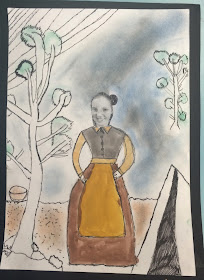 |
| By Aiden |
Lesson Background:
We have been learning about the solar system and designing, making & appraising lunar buggies for our Science & Technology unit on Space this term. We created these astronaut artworks to "space-ify" our classroom and present at our assembly.
Lesson Materials (per student):
2 sheets A3 black thick paper or card (taped together at the back to make 1 large sheet)
5-6 sheets white A4 paper
A black marker or sharpie
Coloured markers
A lead pencil
A black fine liner
A glue stick
1 sheet A4 smooth silver card or paper
Some scraps of silver corrugated card or patterned/textured card
Scissors
Gold and silver paint
A cotton bud
Gold and silver star stickers (optional)
Lesson Steps:
1. Trace around both hands and feet on the white paper, using a lead pencil. Then re-outline in black sharpie marker.
2. Draw patterns on the soles of the feet outlines, using the black sharpie. Try to use a mixture of thin and thick lines.
3. Draw lines, patterns or pictures on the hand outlines to make them look like astronaut gloves.
4. To make the torso, gently fold a sheet of white paper in half (portrait-wise), without pressing down the crease. On the folded side, use your scissors to gently cut into the paper and round the edge of the top corner (to make shoulders). Then cut on the diagonal across the bottom fold (to make the 'undies' line). Finally, cut a slight curve into the middle of the fold, to create a waist.
5. Using the black sharpie and fineliner, draw in details on the torso (buttons, zippers, pockets, etc. Add in silver card and collage materials to make belt buckles, press studs, etc.
6. On some white paper, draw a circle (having a template helps) for the helmet.
7. On the smooth silver card, draw a large capital 3D letter D (having a template helps) with the middle cut out, to make the helmet visor.
8. Stick the visor onto the white helmet, and fill inside the "D" with the astronauts face, using coloured markers.
9. On the black background sheets, use the cotton bud dipped in the gold and silver paint to make small and big dots for stars. When dry, add sticker stars as well. You could also add marbled or soft-pastel drawn planets if you had the time and resources.
10. Stick the torso onto the background, with the head at the top, and then place the hands over the shoulders and the feet over the 'undies line'.
NOTE: The more colour and detail put onto the astronaut's face and clothing, the better the final effect!
Student Artworks:
















































